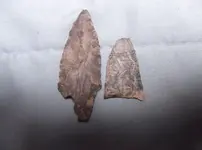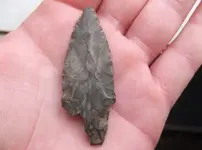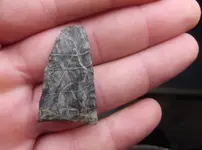GTP, here is the description from Boudreau's 2008 guide, also put out by the MAS. BTW, I consider it the best guide specific to the 6 state New England region, especially southern New England, NOT the entire Northeast, I never said the entire Northeast. From p. 23. "Brewerton Eared Triangles have triangular or lanceolate blades. Basal tangs or 'ears' are similar to Brewerton Eared-Notched, but much less pronounced. This is due to the retention of the lowest portion of the blade edge which is widely removed in the Eared-Notched form. In some cases the ears are barely discernable. ONE EARED FORMS ARE NOT UNUSUAL(again, my emphasis). The ears may be ground. These points are always widest at the base." I cannot reproduce Jeff Boudreau's page here. Jeff earns money from the sales and I don't want to violate his copyright. One reason I consider it the best guide for my region is his high res photos can even be studied under a loupe to study the lithic matetial closer. As for my own points I posted, typology can be tough and as much an art as a science, IMHO, so feel free to call them Levannas or Madisons. But I should tell you the 3 people I consider the most experienced prehistoric archys working in RI have seen them and called them Late Archaic Brewerton Eared Triangles, single-ear form. I have collected in RI and Ma for more then 50 years. Does not make me an authority at all, but every experienced collector I have known has been familiar with this variant and found examples. Bottom line: the variant exists and has been recognized for decades, it's hardly NEW. If you cannot find any reference for these one-eared forms, I can at least provide these 2 for you. If I understand Hoffman correctly, they may not be a common variant outside southern New England, but they are certainly common enough here in my experience and that of the many collectors I have known. BTW, great frame, thanks for sharing.







 Charlie
Charlie